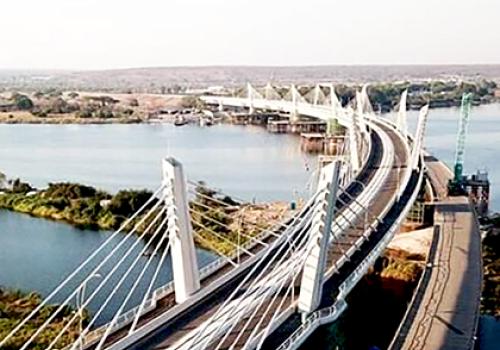The Southern African Development Community (SADC)’s blueprint, the Regional Indicative Strategic Development Plan (RISDP) 2020-2030, places importance on the development of good infrastructure that will spur economic activity across the Region.
Economic transformation of the SADC Region requires adequate and functioning infrastructure that will guide the Region towards front-loading industrialisation in the context of evolving technologies.
The RISDP 2020-2030’s Pillar II on Infrastructure Development in support of Regional Integration aims to promote an interconnected, integrated, and quality seamless infrastructure and networks, including cross-border infrastructure, which will be pivotal in facilitating the movement of people, goods, services, and knowledge.
As a result, in the RISDP 2020-2030, priority is also placed on ensuring harmonised policies, strategies, and initiatives in support of cross-border infrastructure and services.
Recognising that the requisite regional infrastructure and services hold the key to economic development and regional integration, ensuring affordable access to such infrastructure and services is vital.
RISDP 2020-2030 identifies diversified regional infrastructure and services as fundamental for facilitating the movement of goods, services, and skills, as well as the development of regional markets for energy, including renewables; information and communications technology; water; and transport.
In its pursuit to industrialise and accelerate regional integration, SADC has prioritised infrastructure development, and a number of infrastructure projects have been, and continue to be implemented in energy, transport, information communication technologies, meteorology, trans-boundary water resources and tourism (trans-frontier conservation areas).
The targets for infrastructure are set in the SADC Regional Infrastructure Development Master Plan (RIDMP) approved in 2012 that aims at attaining assimilated, cost-effective, unified and efficient transnational infrastructure networks and services to serve as the enablers of regional integration and economic development.
There are a number of infrastructure projects that have been implemented or are ongoing in the SADC Region.
One-Stop Border Posts have been established at Chirundu Border between Zambia and Zimbabwe; Nakonde-Tunduma Border between United Republic of Tanzania and Zambia; and Kazungula Border between Botswana and Zambia, where the road-rail bridge was commissioned in May 2021.
The Kazungula Bridge and One-Stop Borders between Botswana and Zambia, and at Nakonde-Tunduma, link the port of Durban in South Africa to the Democratic Republic of Congo (DRC) and the United Republic of Tanzania through the North-South Corridor, facilitating seamless and efficient movement of goods and persons, and reduce the cost of doing business, contribute to industrialisation, and enhance trade and SADC regional integration. This subsequently extends to the Common Market for Eastern and Southern Africa-East African Community-SADC Tripartite Regions, and eventually the African continent through the corridor approach that has been adopted by COMESA, EAC, SADC, and the African Union.
Between 2014 and 2020, there has been installation and commissioning of more than 18300 Megawatts (MW) of power to meet the increasing power demand in the Region.
Power is a key enabler of economic activity and more power generated in the SADC Region results in increased economic development for the benefit of citizens Other infrastructure projects include cross-border transmission links using optical fibre technology to allow landlocked Member States such as Botswana, Eswatini, Lesotho, Malawi, Zambia and Zimbabwe to connect to the submarine cables on either or both the east and west coasts of Africa have been established.
In addition, five Member States (Botswana, Eswatini, Namibia, South Africa and United Republic of Tanzania) have achieved the 2025 SADC Broadband Target to cover 80 percent of their population with broadband services and Regional Broadband interconnectivity as a critical technology in addressing and recovery from natural disasters and pandemics. National Broadband Plans or Strategies have been established by eight Member States — Angola, Botswana, Eswatini, Mauritius, Mozambique, Namibia, South Africa, and United Republic of Tanzania.
There has also been significant progress in the SADC mobile penetration. All SADC Member States have established at least two cross-border terrestrial optical fibre links for regional and international transit traffic, and the SADC mobile penetration has increased from 60% in 2012, and currently stands at 77.4%, with five Member States exceeding 100% mobile penetration.
The SADC Internet User Penetration has also increased from 4% in 2012 to 22.9% in 2020. In terms of coverage of mobile services, the SADC average population coverage by a mobile network is 88%, whereas the SADC average population coverage by at least 3G Mobile is 80%, and 54% for a 4G Mobile Network.
Increased use of cross border transmission links, broadband, mobile penetration and internet user penetration benefit SADC citizens who are now able to access information from around the world faster and easily. Information and communication technologies (ICTs) have become the lifeblood of the knowledge economy. Affordable access to ICTs is a human right as well as a significant contributor to economic growth and social well‐being. ICTs ensure that SADC citizens have full access to modern technologies.
The RISDP 2020-2030 Pillar on Infrastructure Development is therefore vital in ensuring there is sound infrastructure across the Region which is a key enabler for economic development and regional integration.

